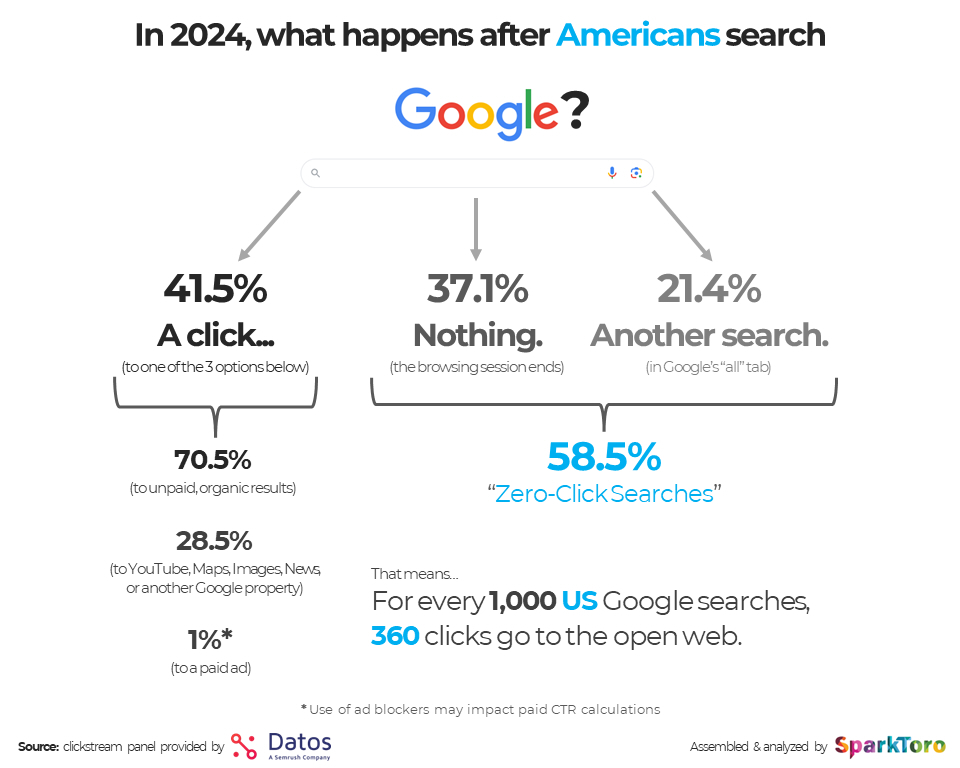
Destination organizations are navigating an evolving digital search landscape shaped by AI-powered "answer engines" and the rising prominence of zero-click searches. Tempest shares how to adapt content strategies and maximize visibility in this shifting ecosystem.
Destination organizations are navigating an evolving digital search landscape shaped by AI-powered "answer engines" and the rising prominence of zero-click searches. Tempest shares how to adapt content strategies and maximize visibility in this shifting ecosystem.
A New Era in Search
The search ecosystem has undergone significant transformation, with Google introducing more algorithm updates in the past year than ever before. AI-powered answer engines such as Google Gemini and ChatGPT are reshaping how queries are answered. Additionally, the rise of zero-click searches and search-friendly platforms like TikTok and Reddit has changed the way people find and consume information.

Despite these shifts, organic search remains a cornerstone for driving cost-effective traffic. For many destination organizations, it continues to represent a significant portion of overall website sessions and is often a key driver of growth.
Now is not the time to abandon organic search. Instead, it’s time to adapt and strengthen your destination’s content efforts to remain competitive in 2025 and beyond.
1. Creating Anticipatory, Engaging Content
Many of Google’s recent updates prioritize delivering helpful content in the search results, and answer engines like Google Gemini, Perplexity, Claude, and ChatGPT rely on citing reliable, authoritative sources to deliver responses.
The truth is, AI tools (and Google search, for what it’s worth) are only as good as the content they are able to retrieve. This creates a powerful opportunity for destination websites: position your content as the definitive source for destination information (which should have always been the goal!).
Rather than pulling back on content creation in the face of AI advancements and algorithm updates, now is the time to double down. Google’s E-E-A-T (Experience, Expertise, Authority, Trust) guidelines should be top of mind in these efforts, with your content demonstrating first-hand expertise, credibility, and relevance — all with the goal of convincing AI models and search engines that your site is the most trusted resource available.
A few examples of high-impact content opportunities include:
- “Destination Driver” content: Create evergreen guides for marquee attractions and annual events, complete with FAQs, ticket prices, and transportation advice.
- Seasonal showcases: Develop season-specific activity lists like “Winter festivals in [City]” or “Top kid-friendly hiking routes for summer” to offer more curated information.
- Local insights: Enhance your storytelling with localized insights, such as insider tips from residents or local influencers, lists of local hidden gems, and thoughtfully assembled dining recommendations.
It’s important to underscore that content is only valuable if it’s accurate. Keeping your website’s content up to date will position your destination website as a reliable, ongoing resource — one that Google and AI-driven engines can confidently cite.
TIP: Don’t ignore your existing content that may just need a fresh coat of paint. Now may be an excellent opportunity to start a thorough inventory and audit of your website’s content. When doing so, ask yourself “is this website content helpful, reliable, and accurate? Will this actually help a visitor or planner? Does it serve a unique purpose on the internet?”
2. Leveraging Long-Tail Keywords for Greater Visibility
Broad keywords like “things to do in [city]” or “restaurants in [destination]” (which destination organizations once dominated in Google rankings) are losing their impact. These searches are now dominated by AI overviews, People Also Ask sections, Knowledge Panels and other features that push down the coveted “blue links” we engineer for website clicks. Users are now getting answers directly on the search page, leaving fewer opportunities for clicks on traditional organic links.
The solution lies in shifting focus to more niche, intent-based keywords that face less competition from SERP features. Long-tail keywords — phrases like “dog-friendly hotels near downtown” or “restaurants open late in [city]” — attract more engaged users ready to take action.
Focus on having website content that profiles neighborhood-specific events, businesses, and attractions that your organic competitors may not. Also look to identify trending topics and questions that capture search intent further down the decision-making funnel. Explore long-tail topics related to some key attractions, such as “top exhibits at [museum],” to broaden your share of voice for those topics in both search and AI tools.
3. Competing with AI-Driven SERPs and Zero-Click Searches
An increase in the prominence of AI-powered answers and rich SERP features are transforming how users interact with organic search. So much so, that nearly 60% of searches in the U.S. now result in zero clicks. In order to have a presence in this new reality, destination websites need to adapt their content to match how these features cite and deliver answers.

In addition to tried-and-true SEO strategies, use structured data to increase the chances of your content appearing in Knowledge Panels and featured snippets, and to make it easier for AI tools to scan and understand your content. Further, consider adopting a conversational tone with your content, which more closely aligns your writing style with the natural cadence of AI chatbot queries.
4. Establish Your Authority to Build Trust and Visibility
In a search landscape increasingly driven by E-E-A-T principles, demonstrating your credibility is essential for earning visibility in both traditional search engines and AI-powered tools. Destination organizations are uniquely positioned to establish authority by showcasing their official status as trusted sources of information for their communities. A few key strategies to reinforce your authority include:
- Acquire authoritative backlinks: Build partnerships with local businesses, media outlets, and tourism influencers to generate inbound links. These not only enhance your site’s domain authority but also signal to search engines that your content is credible.
- Add blog authors to posts: Showcase expertise by including author bios for blog entries. Readers, Google, and AI tools alike are more likely to trust content when it’s attributed to professionals with relevant experience or local insights.
- Enhance your "Who We Are" page: Use this section to highlight your organization’s role as the official tourism agency for your community. Demonstrate your authority by sharing your mission, expertise, and deep connections to local partners.
5. Prioritizing Clear Content Structure and Thoughtful Presentation
Well-organized content plays a key role in both search visibility and user engagement. A clear information architecture — with a logical sitemap grouping content into intuitive categories (e.g., Attractions, Events, Lodging) — helps both users and search engines navigate your site efficiently.
Equally important is how content is presented within each page or blog entry. Break up text with concise headings, bullet points, and short paragraphs to create scannable sections. This structure not only engages users but also makes it easier for AI tools to parse and surface your content in search results.
Using internal links to connect related pages encourages deeper exploration while signaling to search engines how content is interconnected, further boosting visibility.
6. Adapting to New KPIs for Success in 2025
With zero-click searches on the rise, destination organizations should reexamine how they measure success. Metrics like click-through rates and raw session counts no longer tell the full story. Instead, DMOs should focus on new KPIs that reflect visibility and engagement, such as:
- Search visibility: Track how frequently your site appears in AI summaries, Knowledge Panels, and other SERP features.
- Referral traffic: Measure traffic from backlinks, media mentions, and social platforms.
- On-site engagement: Monitor time on page, engagement rate, and key events like newsletter sign-ups or partner referrals.
Embracing the Future of Search
As AI tools become more integrated into search engines and zero-click behaviors continue to rise, destination organizations must stay nimble. Continued search success will require authoritative content, seamless user experiences, and strategic partnerships.
By focusing on E-E-A-T principles, optimizing for long-tail keywords, and building strong content networks, DMOs can maintain visibility, inspire travelers, and drive meaningful engagement no matter where users are seeking information about your destination.
Submit Your Thought Leadership

Share your thought leadership with the Destinations International team! Learn how to submit a case study, blog or other piece of content to DI.


